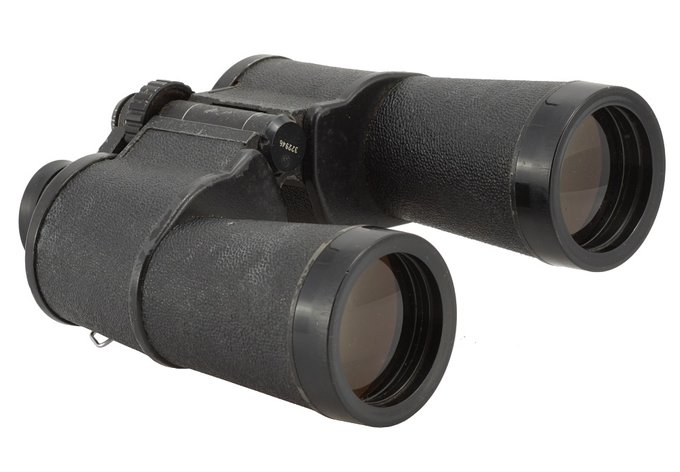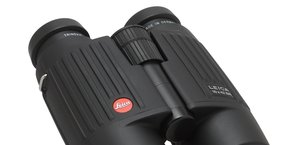Legendary binoculars – the BPC Tento 10x50
1. BPC Tento 10x50
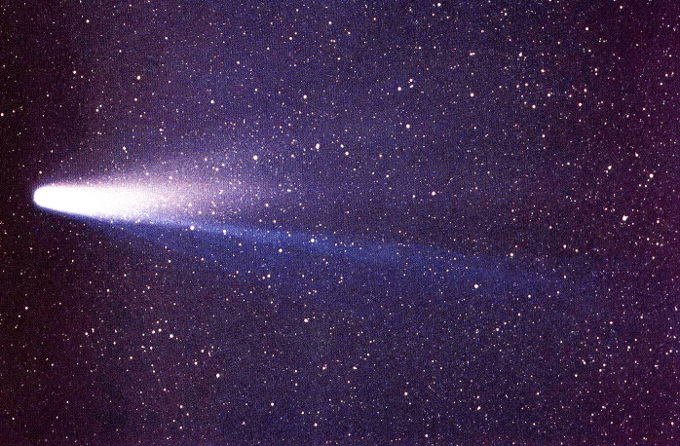 Halley’s comet in 1986. Source: Wikipedia. |
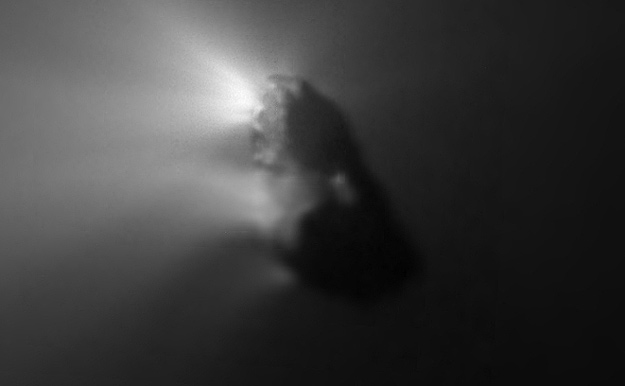 Halley’s comet nucleus photographed by the Giotto space probe during the 1986 flyby. Source: ESA. |
Please Support UsIf you enjoy our reviews and articles, and you want us to continue our work please, support our website by donating through PayPal. The funds are going to be used for paying our editorial team, renting servers, and equipping our testing studio; only that way we will be able to continue providing you interesting content for free. |
- - - - - - - - - - - - - - - - - - - - - - - - - - - - - - - - - - - - - - - - - - - - - - - -
The other idea was to buy a pair of binoculars but I wasn’t consulted when it came to the choice of the model because my dad decided it was going to be a surprise gift for me. One day, most likely at the beginning of 1986, I found the BPC Tento 10×50 in our house. I will always remember the day I handled it for the first time, how I took it out of the box and then out of its case, that cold touch of metal and a specific but very pleasant smell…
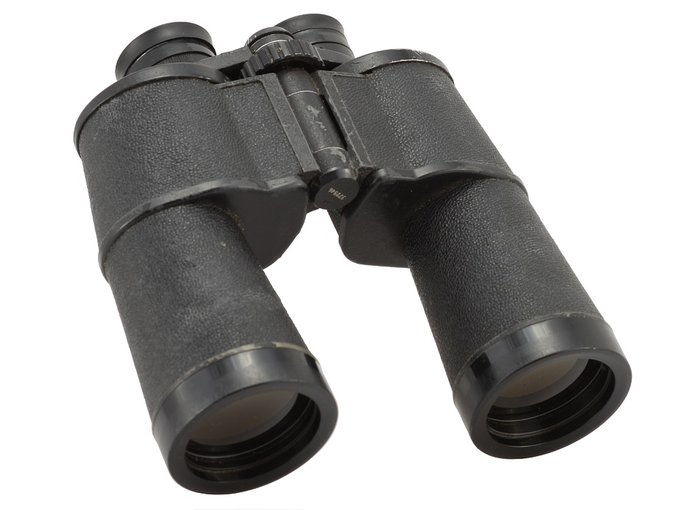 |
At first I didn’t keep that promise because I was too much into photography at that time, my second big passion. Instead of using the gifted pair of binoculars I spent most of my time in the local Community Centre, using its darkroom, developing classic ORWO analogue films or forcing Fotopans HL 400 ASA to speeds several times higher so they were more suited for astrophotography.
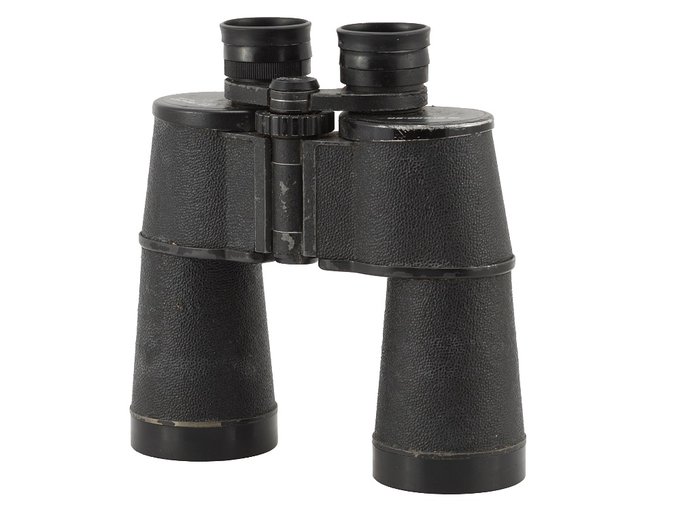 |
During 1989 summer holidays my astrophotographic passion was already a bit satiated so I started to listen to dr Marek Muciek from the N. Copernicus University in Toruń more carefully. As a coordinator of the PTMA Comets Observers’ Section he encouraged everyone to tackle that topic. I found out my a bit dusty BPC 10×50 is simply a perfect tool for observing bright comets and an opportunity to use it in practice was coming very soon. In August and September the same year another short-period cosmic object belonging to the Halley –type comet family, the 23P/Brorsen-Metcalf comet, was supposed to have a flyby over our country. Its orbital period amounts to 70.5 years so waiting for the next chance seemed rather risky. I decided I wouldn’t let that opportunity pass by.
Still it wasn’t easy, mainly due to the fact that the comet played a trick on its observers. Before 1989 only its two flybys were documented so the number of observations and their precision weren’t exactly great. Despite these difficulties David Yeomans made calculations and presented an ephemeris according to which big telescopes of that day should have located the comet already in early spring 1989. Unfortunately nobody informed about such observations. The comet became visible only at the beginning of July and in a distance differing by 15 degrees from the designated place. The differences didn’t mean Yeomans made a mistake because the comet followed exactly the calculated path, but there were non-gravitational effects at play which meant the comet exceeded its scheduled ‘timetable’ by almost two weeks.
The Brorsen-Metcalf comet action was the first done by the SOK PTMA after its reactivation and the surprise sprung on us by the comet complicated the matter a lot. All ephemerides and maps sent to the observers could be torn and thrown away. Keep in mind the fact I am talking about a pre-Internet era when all messages had to be sent by ‘snail mail’. It meant that weeks passed from first observations, performed in July, and comprising a new ephemeris which was sent via a telegram of International Astronomic Union, to making, printing and sending new maps; most of observers got them well after 20th August. During previous nights they were looking for the comet in vain because they were looking in the wrong place. Additionally, the new comet path was even less advantageous for Polish observers than the old one.
As I’ve already mentioned that time I was determined not to repeat my Halley’s Comet fiasco. I wanted to use the beginning of September when the comet was supposed to be at its brightest. The object was supposed to be visible early in the morning; fortunately the first September weekend was also the second and the third day of that month, making summer holidays a bit longer. At that time I lived in Pruszcz Gdański, only 10 km from Gdańsk heavily polluted by street light, hardly an ideal place for astronomic observations. To improve the observation conditions I decided to visit my grandparents who lived in a village called Tczewskie Ł±ki.
The night between 1st and 2nd September was cloudless. I got up at about 3 a.m. and prepared myself for observations. I had a map and the Tento BPC 10×50 binoculars close by and ready. From 4.0 a.m. to 4:30 a.m. I managed to notice a blurry spot exactly in the place indicated by new ephemerides – it was the first comet observed by me in my life, the main object of my interest that night. Its apparent magnitude I assessed as 6.2. Below I present the notes from my observation diary with the map and the position of the comet.
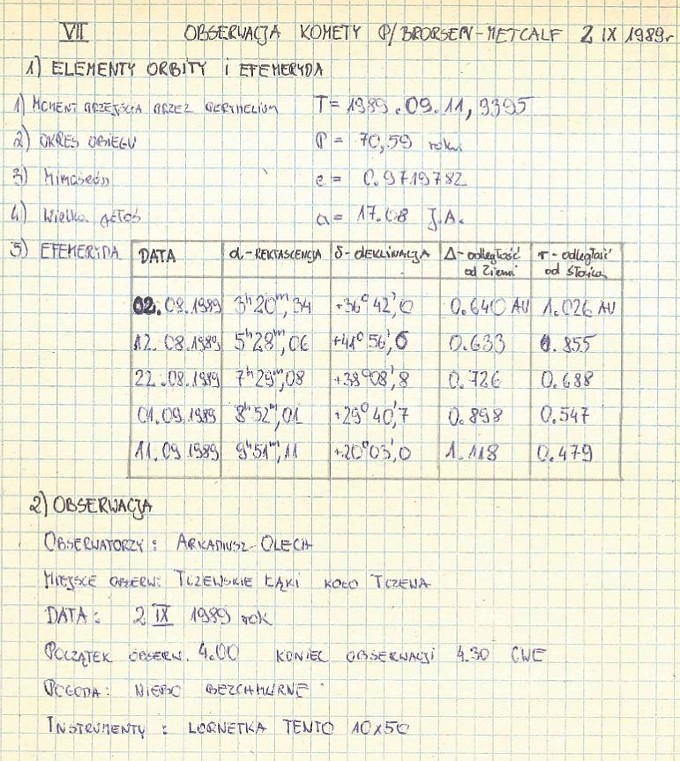 A fragment of the observation diary of the author of this article from the night between 1st and 2nd September 1989. |
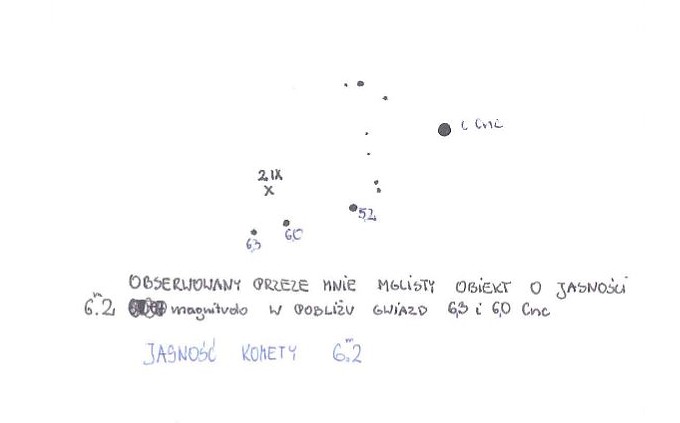 A sketch of the Brorsen-Metcalf comet position and the position of close stars during the 1st/2nd September 1989 night observation performed by the author of this article. |
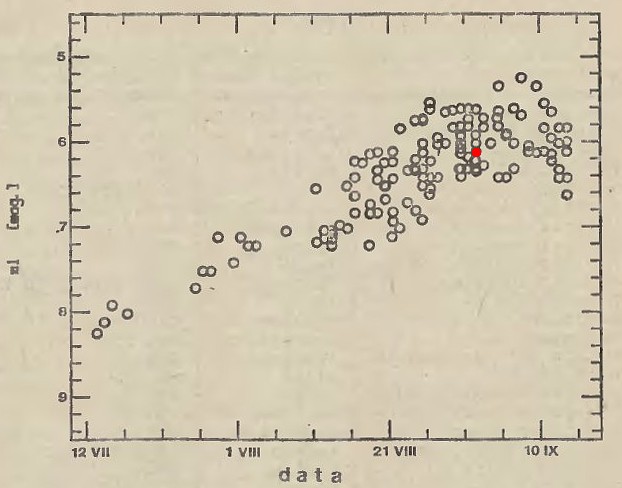 The Brorsen Metcalf comet light curve graph according the SOK PTMA observations. The red dot indicates the result got by the author of this article. |
I enjoyed comet observations very much and soon I became a real fan. As the following years didn’t lack of bright celestial phenomena I soon could boast of several dozen observation nights under my belt, capturing such objects as the Austin and Levy comets. All that time the inestimable Tento 10×50 was my faithful companion and in 1990 it got a friend in a form of the bigger 20×60 model.
Forgive me such a long and personal astronomical and historical digression but I feel it justifies the idea behind this article. The fact is that the Tento BPC 10×50 binoculars can hardly be compared to other models presented in our ‘Legendary binoculars’ cycle but for me personally it is a truly legendary device. After all it is my first pair of binoculars which nourished my photographical and astronomical passion. I suppose plenty of people born and bred in the Eastern Bloc countries would agree with me. Let’s progress now to a short presentation of the main character of our article.
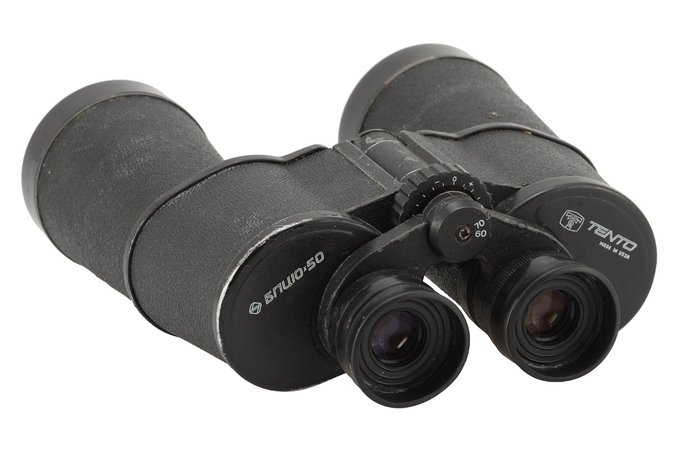 |
The main supplier of Technointorg products were Zagorsk Optical-Mechanical Plant (Загорский оптико-механический завод, ZOMZ) placed in Sergiyew Posad, 70 km from the centre of Moscow. As it is a well-known Russian factory which constructed many good quality models of binoculars perhaps we should say something more about it.
A decision to build a Soviet factory which would produce optics instruments of different kinds was taken in June 1934 as a part of the second 5-year plan. The decision was implemented very quickly because already in September 1935 the first pilot plant was created and in April 1936 the first instruments, Brinell microscopes, were produced.
In 1941, after the Nazi III Reich attack, the ZOMZ industries were moved to Tomsk as German armies were approaching Moscow. In 1942 there was already a full scale production of optical instruments for the Russian Army. In summer 1943, when the Germans withdrew, the industries returned to Sergiyev Posad.
The ZOMZ produced first civilian pairs of binoculars in 1947 – it was a theatrical 2.5×24 model. In 1951 two other prismatic 3.5×15 and 6×18 instruments were released.
The project of the BPC Tento 10×50 binoculars, described in this article, was designed near the end of the 60s of 20th century. First specimens which looked exactly as the one my dad bought me in 1986, appeared at the beginning of the 70s. In the middle of the 80s these were binoculars found most often in Polish shops. It doesn’t mean they were available all the time, quite the opposite; even though they cost as much as half of average monthly income of that time they were never easy to get.
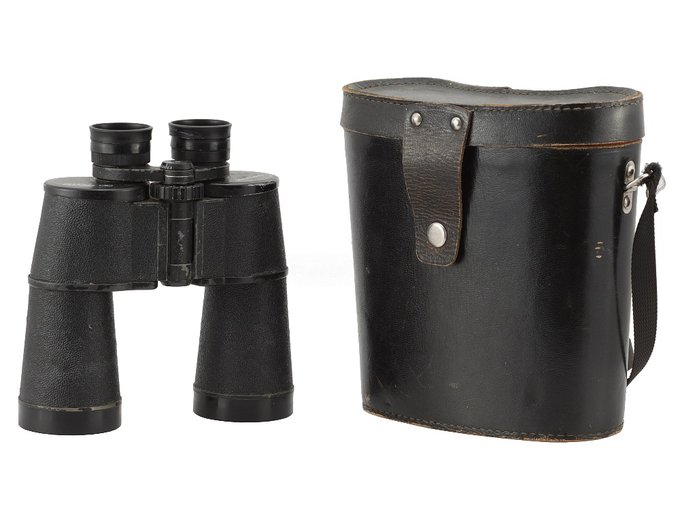 |
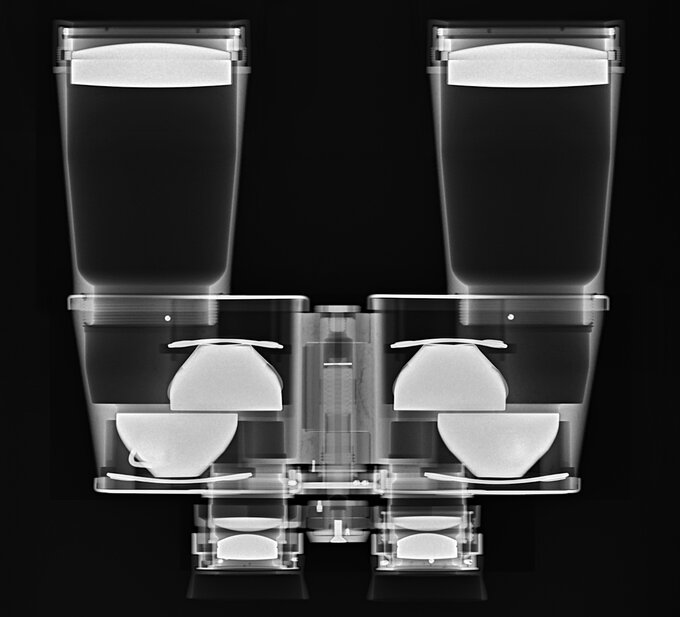 X-ray photo of the BPC Tento 10x50 binoculars. Phot. Obserwatorek |
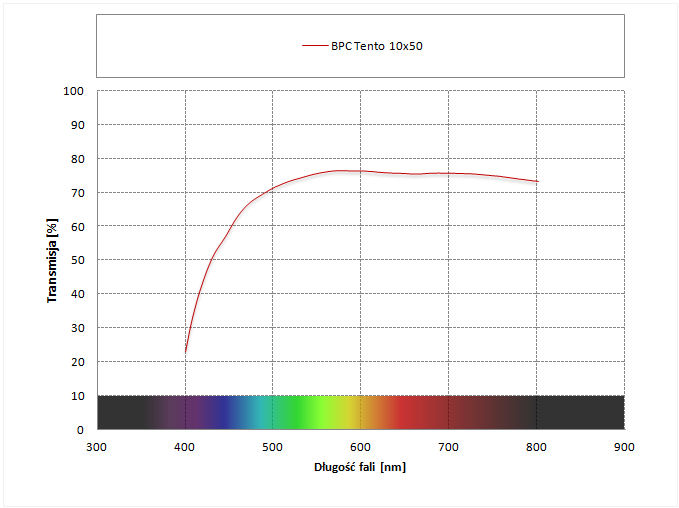
The transmission graph of the BPC 10×50 model, shown above, explains why the image provided by this pair of binoculars is so yellow. The more or less flat transmission can be observed only in the range from 560 to 800 nm. Below 560 nm you see a very distinct drop so there’s a slight shortage of green light, a significant shortage of blue light and huge shortage of purple light. The highest values which are still on a very mediocre level of about 76% you get in the 560-620 nm range so exactly in a place where yellow-orange light dominates.
Magnesium fluoride coatings mean the loss of light on one air-to-glass surface decreases from less than 5% to about 1.5%. The BPC Tento 10×50 features 10 air-to-glass surfaces (two on the objective lens, four on air spaced prisms, four on the eyepiece). It means that the maximum transmission should be around 85%. The result of 76% is noticeably lower. The glass absorption should be blamed for only one part of that loss and it seems the main culprit is the age of the binoculars and, stemming from it, the wear and tear of antireflection coatings.
When it comes to the casing it is made of metal and padded with characteristically textured leatherette material. The binoculars feature a classic ocular bridge and a dioptre adjustment on the right eyepiece, ranging from -3 to +3 dioptres. Eyecups are made of rubber so they could be folded – a recommendable solution for people wearing glasses.
Buyers got a hard case made of leather with a strap, a quite thin strap for the binoculars themselves, four protective caps and yellow-green filters which, taking into account strong yellowish tint provided by the optics itself, were a kind of practical joke.
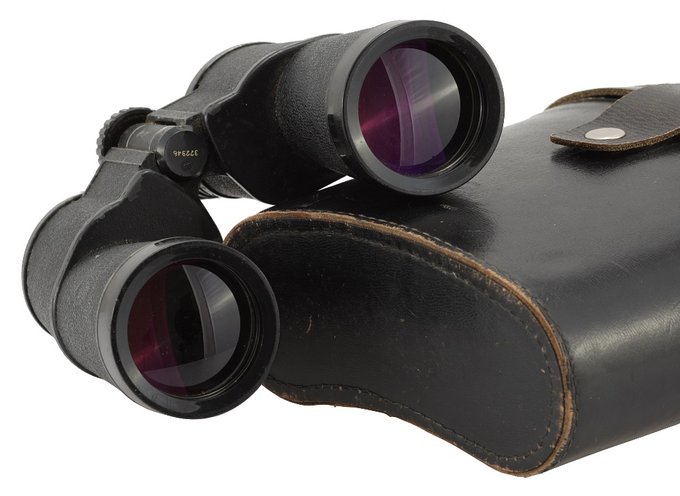 |
It’s worth adding that the model, described here, was changed and improved later (at the turn of 80s and 90s of the previous century). The new Tento BPC5 10×50 had a field of view of 6 degrees and its eye relief distance amounted to 15.3 mm. Its appearance also changed, becoming more similar to Jena products, with shorter tubes of objectives and longer prism housings. Additionally the coatings had a different colour, suggesting more than one layer.
Many generations of passionate observers living behind the Iron Curtain were using different BPC binoculars, especially the 8×30, the 7×50 and the 10×50 models. I am sure many of those who are now close to my age or older will agree with me: for us the BPC Tento 10×50 is and will remain a legendary, cult model.




